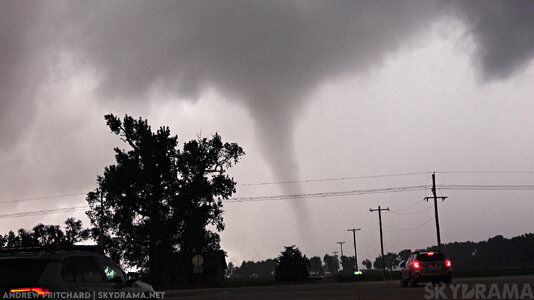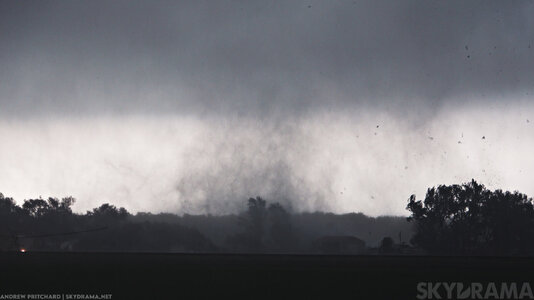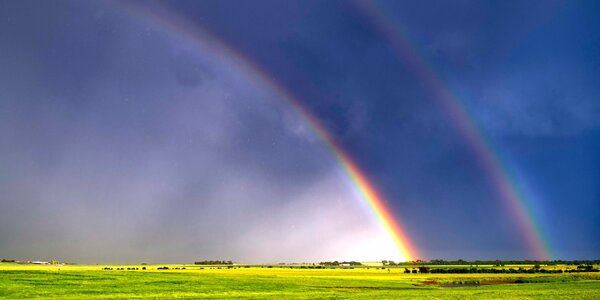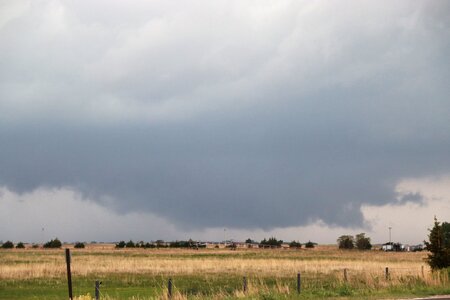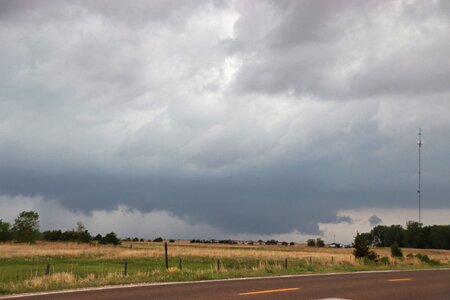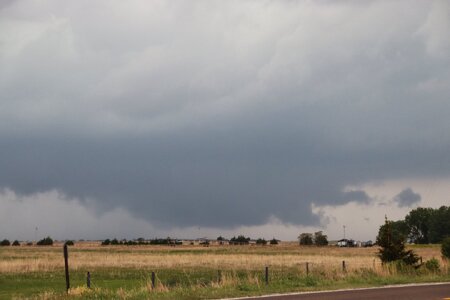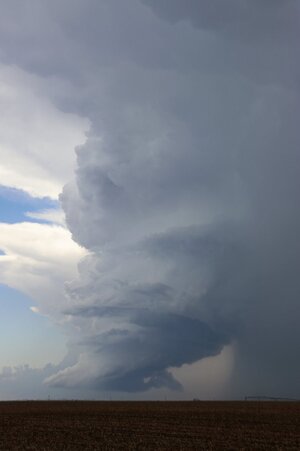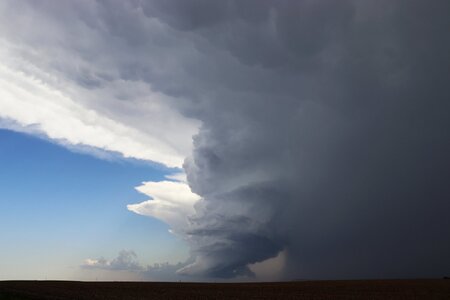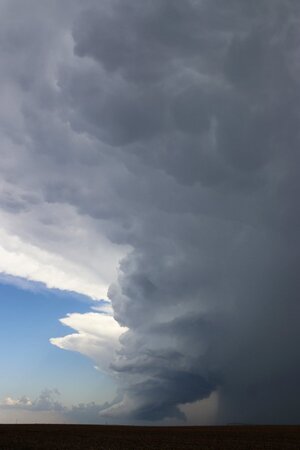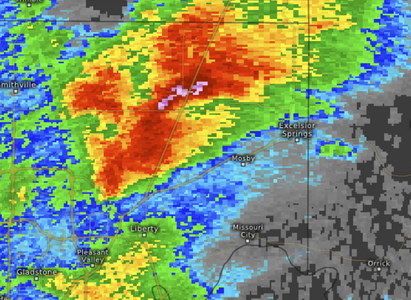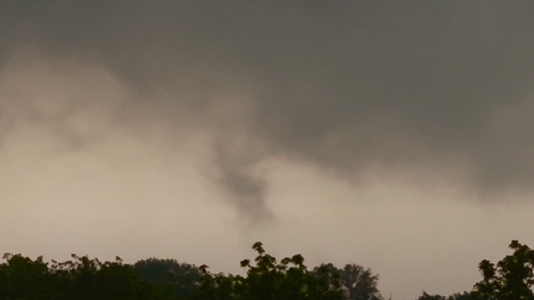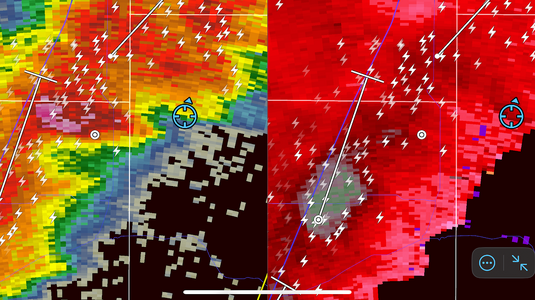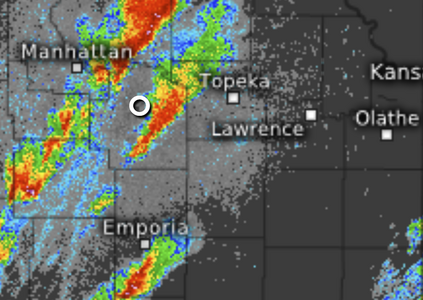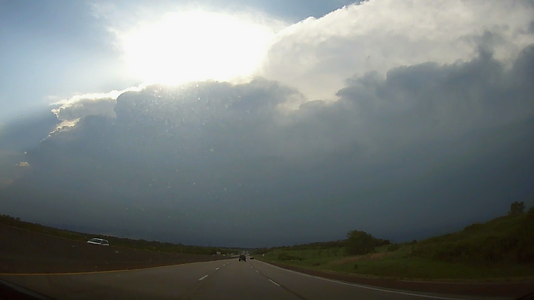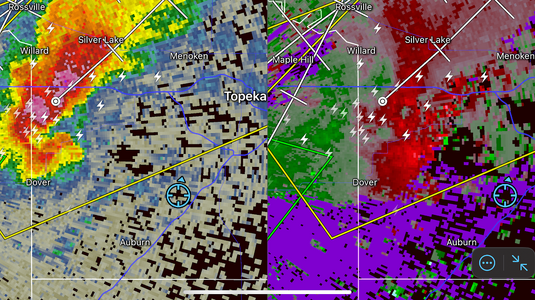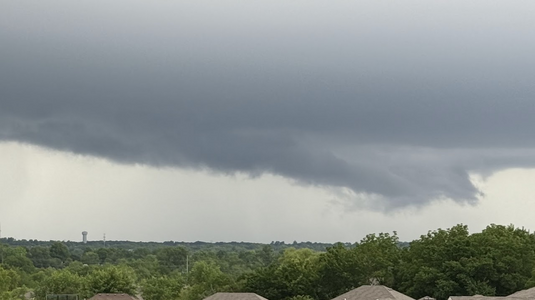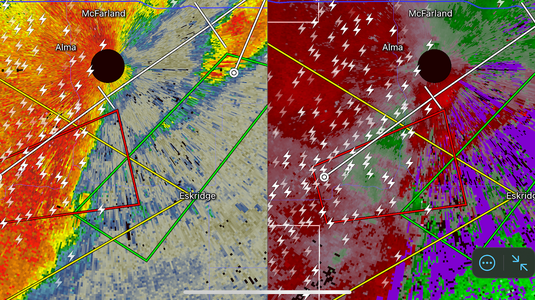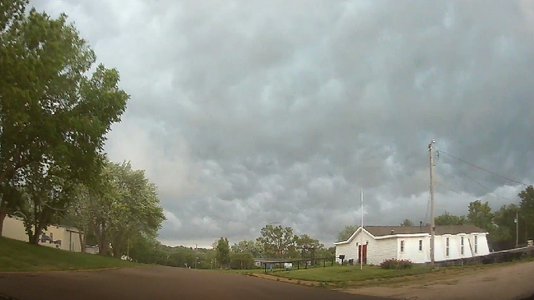Dan Robinson
EF5
Targeted the dryline bulge at Marysville, Kansas and saw a brief, weak dust whirl tornado under a funnel east of Du Bois, Nebraska. Chase log:
I started the day at 10am in Junction City. I didn't do much of a proper forecast today beyond looking at satellite and mesoanalysis. Three dryline targets seemed apparent to me during my first data check: a dryline bulge down near the Red River, another along the Kansas/Nebraska border and the moisture tongue curving back into the vorticity-rich surface low in central Nebraska. The CAMs showed wildly varying depictions on how the day would evolve with each new run, so I did not put much stock in what they were saying. The only insight they gave was that the day looked potentially messy with likely a lot of storms going up everywhere.
Storms had already fired at the early hour down in southern Oklahoma, so I feared the cap was too weak there. That left the KS/NE border dryline bulge and the surface low. I chose the former, as satellite showed an encouraging picture of a broad zone of clearing between the dryline and cloud cover/precip to the east in Missouri. I headed up to Marysville, Kansas as my initial target.
I sat and waited near Marysville for about 90 minutes before storms began forming on the dryline immediately to my west and southwest. As I waited for a dominant updraft, things were not taking off as fast as expected. It took a long time for a coherent storm to emerge, and even then, it did not last long. Several other updrafts fizzled out as they passed by me. Finally, a storm just to my south looked like it was finally getting itself together. I dropped south of Home, Kansas for about 5 miles to watch this approach. It was producing a nice RFD, but inflow at the surface seemed weak. Finally, a wall cloud with a better look began organizing near Beattie, KS as I moved north and east to stay with the storm. Cloud tags on the south end of the wall cloud were spinning rapidly, and this motion indicated a tornado could be minutes away.
Unfortunately, I had a road problem at this point. I initially took Deer Trail Road eastward toward St. Bridget, but 2 miles in, the road dead-ended into a three-way intersection with pure dirt roads going north, east and south. With the RFD precip right behind me, those roads were absolute no-gos: they would all be impassable mud within minutes of the rain arriving. I turned around and headed back to the paved main road as the RFD precip passed overhead. I waited for the VIL core (hail) to cross to my north, then headed north across the state line at Summerfield, then east again through Pawnee City hoping to beat the hail before it overtook that road. The storm had slowed some and turned right more, allowing me to make this move without incident. I finally was back in position in the inflow notch of the storm at Du Bois.
Here, the storm was fighting outflow, but surface inflow was countering and making it into several areas along the north side of the RFD gust front, each spinning rapidly. Finally one of those became dominant, and managed to wrap up and produce a weak tornado consisting of a debris cloud under a funnel about a mile northeast of Du Bois:
The outflow was too overpowering for this to last long. A second RFD surge wrapped in about 3 miles to the east of this area, with a visible clear slot:

There may have been something going on back in there, but the precip rapidly filled in and prevented any good view. Radar data did not indicate that anything was likely happening there at that point.
After this, the storm began a long, slow downturn in intensity. In the distant east, a harbinger of the storms' doom loomed: a long arcus cloud marking the edge of outflow from earlier storms in Missouri. This meant the storms here and to the south (in the form of a squall line heading for the St. Joseph and Kansas City areas) would soon hit that stable air and fizzle. That was enough for me to call the chase and begin heading home.
That non-chase mode did not last long! I had initially wanted to beat the heavy rain in the line to I-70 in order to have a mostly downpour-free drive east to St. Louis. But as soon as I passed Platte City, tornado warnings lit up on two very strong-looking couplets on the now-bowing squall line to my north. These were both too close to I-29 for me to make it back up there in time. I considered an intercept on I-35 north, but I felt that there would be no way these would last that far into the stable air. I was right about that (for a change).
Continuing south toward I-70, a structured shelf cloud became visible on the line's outflow heading into Kansas City. Shooting this would only divert me a few hundred feet off of my route, so I stopped on the east side of downtown. The shelf was not very dramatic as it arrived overhead, at least not as good as it had looked from a distance. As a note: this is a bad spot to shoot downtown KC, as the ground slopes upward from left to right and makes it look like the horizon isn't level. I didn't have time to find something better.

My next play was to get to towers in the Columbia, MO area to shoot lightning in stratiform precip that radar showed was moving that way. But it was about this time that I noticed the tornado warnings starting to go off in the St. Louis area. Though missing the May 16 St. Louis tornado had forced me to essentially give up my home target bias (since it had failed so spectacularly and cost me many good events elsewhere over the last 15 years), I was still filled with anxiety watching this evening's events unfold back home from 3 and a half hours away. It appeared there was a boundary (either the warm front or an old outflow) south of the metro area that caused every storm that crossed it to spin up a strong circulation. The first one that happened during the daylight hours was highly visible and photogenic, as Twitter reports showed. To the southwest of all of this, numerous mesovortices along the main squall line were also potentially producing tornadoes. As all of this continued, it looked as if St. Louis might be getting its own "night of the twisters" if whatever boundary was causing this managed to lift into the city. And there was no way I'd make it in time.
I pressed on eastbound, but with resignation. I would miss all of the supercellular tornadoes ahead of the line, but it looked like I had a shot of beating the squall line into downtown. Resignation slowly turned to relief as radar showed surrounding convection enveloping the supercells and disrupting them. It also appeared the tornadogenic boundary was not moving north with the rest of the system, as further spinups were not occurring any closer to the metro area. As I got to within an hour away, the lead supercells had been completely absorbed by competing convection, ending that threat. I managed to beat the squall line into downtown by minutes, but it had also weakened considerably and no longer had any circulations on its leading edge. I was not even seeing much lightning as I drove through the metro area.
I started the day at 10am in Junction City. I didn't do much of a proper forecast today beyond looking at satellite and mesoanalysis. Three dryline targets seemed apparent to me during my first data check: a dryline bulge down near the Red River, another along the Kansas/Nebraska border and the moisture tongue curving back into the vorticity-rich surface low in central Nebraska. The CAMs showed wildly varying depictions on how the day would evolve with each new run, so I did not put much stock in what they were saying. The only insight they gave was that the day looked potentially messy with likely a lot of storms going up everywhere.
Storms had already fired at the early hour down in southern Oklahoma, so I feared the cap was too weak there. That left the KS/NE border dryline bulge and the surface low. I chose the former, as satellite showed an encouraging picture of a broad zone of clearing between the dryline and cloud cover/precip to the east in Missouri. I headed up to Marysville, Kansas as my initial target.
I sat and waited near Marysville for about 90 minutes before storms began forming on the dryline immediately to my west and southwest. As I waited for a dominant updraft, things were not taking off as fast as expected. It took a long time for a coherent storm to emerge, and even then, it did not last long. Several other updrafts fizzled out as they passed by me. Finally, a storm just to my south looked like it was finally getting itself together. I dropped south of Home, Kansas for about 5 miles to watch this approach. It was producing a nice RFD, but inflow at the surface seemed weak. Finally, a wall cloud with a better look began organizing near Beattie, KS as I moved north and east to stay with the storm. Cloud tags on the south end of the wall cloud were spinning rapidly, and this motion indicated a tornado could be minutes away.
Unfortunately, I had a road problem at this point. I initially took Deer Trail Road eastward toward St. Bridget, but 2 miles in, the road dead-ended into a three-way intersection with pure dirt roads going north, east and south. With the RFD precip right behind me, those roads were absolute no-gos: they would all be impassable mud within minutes of the rain arriving. I turned around and headed back to the paved main road as the RFD precip passed overhead. I waited for the VIL core (hail) to cross to my north, then headed north across the state line at Summerfield, then east again through Pawnee City hoping to beat the hail before it overtook that road. The storm had slowed some and turned right more, allowing me to make this move without incident. I finally was back in position in the inflow notch of the storm at Du Bois.
Here, the storm was fighting outflow, but surface inflow was countering and making it into several areas along the north side of the RFD gust front, each spinning rapidly. Finally one of those became dominant, and managed to wrap up and produce a weak tornado consisting of a debris cloud under a funnel about a mile northeast of Du Bois:
The outflow was too overpowering for this to last long. A second RFD surge wrapped in about 3 miles to the east of this area, with a visible clear slot:

There may have been something going on back in there, but the precip rapidly filled in and prevented any good view. Radar data did not indicate that anything was likely happening there at that point.
After this, the storm began a long, slow downturn in intensity. In the distant east, a harbinger of the storms' doom loomed: a long arcus cloud marking the edge of outflow from earlier storms in Missouri. This meant the storms here and to the south (in the form of a squall line heading for the St. Joseph and Kansas City areas) would soon hit that stable air and fizzle. That was enough for me to call the chase and begin heading home.
That non-chase mode did not last long! I had initially wanted to beat the heavy rain in the line to I-70 in order to have a mostly downpour-free drive east to St. Louis. But as soon as I passed Platte City, tornado warnings lit up on two very strong-looking couplets on the now-bowing squall line to my north. These were both too close to I-29 for me to make it back up there in time. I considered an intercept on I-35 north, but I felt that there would be no way these would last that far into the stable air. I was right about that (for a change).
Continuing south toward I-70, a structured shelf cloud became visible on the line's outflow heading into Kansas City. Shooting this would only divert me a few hundred feet off of my route, so I stopped on the east side of downtown. The shelf was not very dramatic as it arrived overhead, at least not as good as it had looked from a distance. As a note: this is a bad spot to shoot downtown KC, as the ground slopes upward from left to right and makes it look like the horizon isn't level. I didn't have time to find something better.

My next play was to get to towers in the Columbia, MO area to shoot lightning in stratiform precip that radar showed was moving that way. But it was about this time that I noticed the tornado warnings starting to go off in the St. Louis area. Though missing the May 16 St. Louis tornado had forced me to essentially give up my home target bias (since it had failed so spectacularly and cost me many good events elsewhere over the last 15 years), I was still filled with anxiety watching this evening's events unfold back home from 3 and a half hours away. It appeared there was a boundary (either the warm front or an old outflow) south of the metro area that caused every storm that crossed it to spin up a strong circulation. The first one that happened during the daylight hours was highly visible and photogenic, as Twitter reports showed. To the southwest of all of this, numerous mesovortices along the main squall line were also potentially producing tornadoes. As all of this continued, it looked as if St. Louis might be getting its own "night of the twisters" if whatever boundary was causing this managed to lift into the city. And there was no way I'd make it in time.
I pressed on eastbound, but with resignation. I would miss all of the supercellular tornadoes ahead of the line, but it looked like I had a shot of beating the squall line into downtown. Resignation slowly turned to relief as radar showed surrounding convection enveloping the supercells and disrupting them. It also appeared the tornadogenic boundary was not moving north with the rest of the system, as further spinups were not occurring any closer to the metro area. As I got to within an hour away, the lead supercells had been completely absorbed by competing convection, ending that threat. I managed to beat the squall line into downtown by minutes, but it had also weakened considerably and no longer had any circulations on its leading edge. I was not even seeing much lightning as I drove through the metro area.
Last edited:

